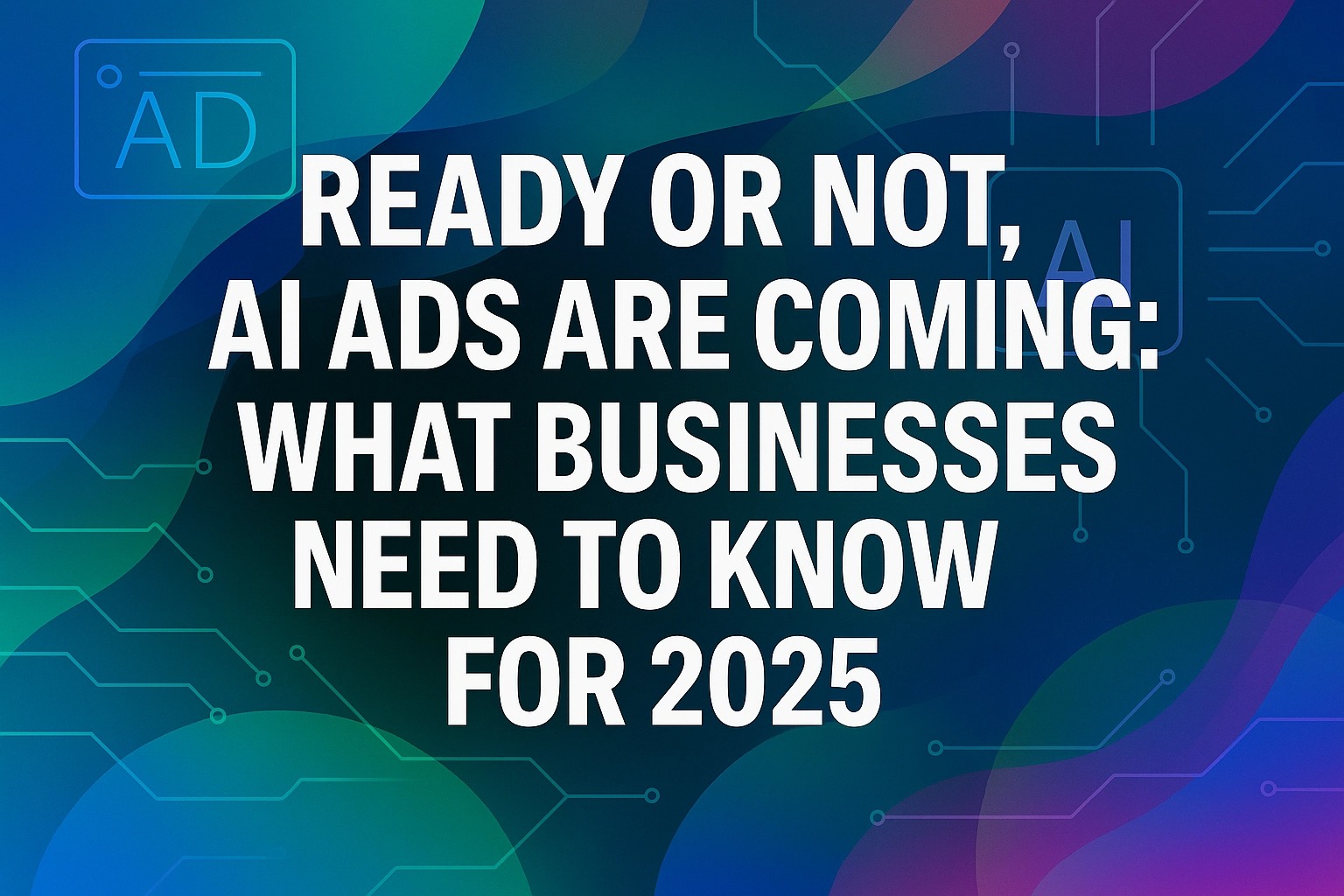The AI Advertising Revolution Is Here
If you’ve been watching the digital marketing landscape lately, you’ve probably noticed something significant: AI isn’t just coming to advertising—it’s already transforming it. For small business owners, this shift represents both an opportunity and a challenge that can’t be ignored.
As of 2024, a staggering 77% of small businesses have integrated some form of AI into their operations. Those who haven’t are quickly finding themselves at a competitive disadvantage. The days of manually tweaking ad copy, guessing at audience segments, and hoping for the best are rapidly becoming relics of the past.
But here’s the good news: you don’t need the resources of a Fortune 500 company to harness the power of AI advertising. With the right knowledge and strategic approach, small businesses can not only adapt to this new reality but thrive in it.
What’s Different About AI-Powered Advertising?
Traditional digital advertising has always been somewhat data-driven, but AI advertising takes this to an entirely new level. Here’s what makes it fundamentally different:
1. Hyper-Personalization at Scale
AI doesn’t just segment audiences—it creates individualized experiences for each potential customer. By analyzing thousands of data points across user behavior, preferences, and engagement patterns, AI systems can now create uniquely tailored ad experiences that would be impossible to replicate manually.
This means your small business can deliver messaging that resonates with each customer’s specific needs and pain points, dramatically increasing conversion rates and customer satisfaction.
2. Predictive Instead of Reactive
Traditional advertising looks backward at what worked before. AI advertising looks forward, predicting customer needs and behaviors before they happen. In 2025, predictive analytics have become sophisticated enough that AI systems can identify potential customers before they’ve even expressed explicit interest in your products or services.
3. Continuous Optimization Without Human Intervention
Perhaps most importantly, AI advertising platforms are constantly learning and improving. While you sleep, these systems run thousands of micro-tests, analyzing which variations perform best and automatically shifting budget toward winning combinations.

Key AI Advertising Technologies Small Businesses Need to Understand
Dynamic Content Creation
Gone are the days of creating dozens of ad variations manually. AI content creation tools have matured significantly, allowing small businesses to generate hundreds of personalized headlines, descriptions, and creative elements automatically.
Platforms like Meta and Google Ads now offer AI-driven creative suggestions that can dramatically improve performance with minimal effort. These systems analyze your website content, customer data, and industry benchmarks to recommend high-converting copy and creative elements.
Advanced Audience Targeting
AI has revolutionized how businesses identify and reach potential customers. Rather than relying on broad demographic targeting, AI systems can now:
- Identify patterns in user behavior that indicate purchase intent
- Create “lookalike” audiences with unprecedented accuracy
- Predict customer lifetime value before conversion
- Target based on sentiment and emotional states
Recommendation Engines
If you’ve used platforms like Amazon or Netflix, you’re familiar with recommendation engines. Now, these same technologies are available to small businesses for advertising purposes. These systems ensure customers see products they’re most likely to purchase, increasing both satisfaction and conversion rates.
For small businesses with limited marketing budgets, this means every ad dollar goes further by targeting only the most promising prospects with the most relevant offers.
Sentiment Analysis
Understanding how customers feel about your brand has always been valuable but difficult to measure at scale. AI-powered sentiment analysis tools can now monitor social media, review sites, and even email communications to gauge customer emotions and adapt your messaging accordingly.
This allows small businesses to address potential issues before they become problems and capitalize on positive sentiment when it arises.
Challenges Small Businesses Face with AI Advertising
While the benefits are compelling, implementing AI advertising isn’t without challenges:
1. The Knowledge Gap
Many small business owners feel intimidated by AI terminology and concepts. This knowledge gap can lead to hesitation in adoption, even when the benefits are clear.
2. Data Quality and Quantity
AI systems require data to learn and improve. Small businesses sometimes lack the robust data sets needed for optimal AI performance, especially when just getting started.
3. Maintaining Authentic Connections
As advertising becomes more automated, there’s a risk of losing the authentic human connection that many small businesses consider their competitive advantage. Finding the right balance between automation and personalization is crucial.
4. Privacy and Ethical Considerations
With increasing concerns about data privacy, small businesses must navigate complex regulations while still leveraging customer data effectively.

Practical Steps to Prepare Your Small Business for AI Advertising
Start Small and Focus on One Challenge
Rather than attempting to overhaul your entire advertising strategy overnight, identify one specific challenge that AI could help solve. Perhaps it’s managing online reviews, optimizing email engagement, or improving social media ad performance.
Starting with a focused application allows you to see concrete results quickly while building organizational confidence in AI solutions. For example, implementing a simple chatbot to handle basic customer inquiries can free up valuable time while providing immediate value.
Audit Your Data Infrastructure
Before diving into advanced AI advertising, take stock of your current data collection and management practices:
- Are you tracking customer interactions across all touchpoints?
- Is your CRM data clean, updated, and properly structured?
- Do you have consent to use customer data for advertising purposes?
- Have you integrated analytics across your website, social platforms, and advertising accounts?
Addressing these fundamentals will set you up for success when implementing more sophisticated AI advertising tools. For more insights on website performance optimization, check out our guide on essential website must-haves for small businesses.
Invest in Learning and Training
The businesses seeing the greatest success with AI advertising are those that view it as a complementary skill set rather than a replacement for marketing expertise. Consider:
- Dedicating time to online courses about AI marketing
- Attending webinars hosted by platforms like Google and Meta
- Setting aside budget for staff training on AI tools
- Following thought leaders in the AI marketing space
Test, Measure, and Iterate
AI thrives on feedback loops. Implement testing protocols to measure the impact of your AI advertising initiatives:
- Set clear baseline metrics before implementation
- Create control groups when possible
- Use A/B testing to compare AI-generated content against human-created content
- Define success metrics beyond just clicks and impressions
- Document lessons learned for future initiatives
Tools like Adobe Target can help streamline this testing process, making it accessible even for small businesses with limited resources.

Real-World Applications for Small Businesses in 2025
Local Service Businesses
For service-based businesses relying on local customers, AI advertising has transformed local search strategy. AI-powered local ads can now:
- Dynamically adjust bidding based on weather conditions (promoting emergency services during storms, for example)
- Target customers based on their proximity to your business in real-time
- Automatically highlight services relevant to seasonal needs
For more information on optimizing your local presence, check out our comprehensive guide on local SEO basics.
E-commerce Retailers
Small online retailers are leveraging AI to compete with larger platforms by:
- Creating dynamic product bundles based on browsing behavior
- Automatically adjusting pricing based on demand signals
- Personalizing product descriptions to match individual customer preferences
- Optimizing ad delivery timing based on previous purchase patterns
Professional Services
Consultants, attorneys, financial advisors, and other professional service providers are using AI advertising to:
- Target potential clients at specific stages of decision-making
- Deliver educational content relevant to individual business challenges
- Adjust messaging based on industry-specific economic indicators
- Highlight specialized expertise based on prospect company profiles
Where to Start: Essential AI Advertising Tools for Small Businesses
If you’re ready to take the plunge into AI advertising, here are some accessible entry points:
1. Google’s Performance Max Campaigns
Performance Max represents Google’s shift toward AI-driven campaign management. These campaigns use machine learning to place your ads across Google’s entire ecosystem, including Search, Display, YouTube, Gmail, and Maps.
Small businesses can start with relatively modest budgets while leveraging Google’s massive data advantages. The platform automatically optimizes for conversions based on your business goals.
2. Meta’s Advantage+ Shopping Campaigns
For e-commerce businesses, Meta’s Advantage+ Shopping campaigns use AI to automate audience targeting, placement, and even creative aspects of your ads. The system dynamically adjusts to find the best-performing combinations, often achieving better results than manually managed campaigns.
3. AI-Powered Copywriting Tools
Tools like Jasper, Copy.ai, and others can help small businesses generate ad copy variations at scale. While human oversight remains important for brand voice consistency, these tools can dramatically speed up the creative process and suggest approaches you might not have considered.
4. Customer Data Platforms (CDPs)
More accessible than ever for small businesses, CDPs help unify customer data from multiple sources, creating the foundation needed for effective AI advertising. Look for solutions specifically designed for small business budgets and needs.
The Human Element: What AI Can’t Replace
With all the excitement around AI advertising, it’s worth noting what remains uniquely human. Effective advertising still requires:
- Brand vision and values that resonate with customers
- Creative storytelling that creates emotional connections
- Ethical judgment about how to use customer data
- Strategic decisions about business goals and positioning
The most successful small businesses in 2025 are those that leverage AI to handle repetitive, data-intensive tasks while focusing human creativity and attention on these strategic elements.
For insights on maintaining authentic connections with your audience, read our article on how to get more 5-star reviews without annoying your customers.
Conclusion: Embracing the AI Advertising Future
The shift to AI-powered advertising isn’t just another incremental change in digital marketing—it represents a fundamental transformation in how businesses connect with customers. For small businesses, the playing field is actually becoming more level as AI tools make sophisticated marketing techniques accessible without enterprise-level resources.
The businesses that thrive won’t necessarily be those with the biggest budgets, but rather those that most effectively blend AI capabilities with authentic human connections. By starting small, focusing on practical applications, and continuously learning, small businesses can not only survive but thrive in the new AI advertising landscape.
Ready to explore how AI advertising can transform your small business marketing? Contact Alkalyne Solutions for a practical assessment of your current strategy and personalized recommendations for integrating AI advertising tools.

